Cottonwood Tree
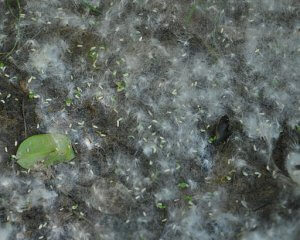
The eastern cottonwood tree (Populous deltoides) is a native North American tree that is common in eastern and central United States as well as southern Canada. Many people recognize this tree from the cottony substance that falls from the trees in early summer. This “cotton” acts as a sail to move the seeds as far from the parent tree as possible. Cottonwood trees are a riparian species which means that they thrive in wet and semi-wet conditions, but these trees can also handle drought which makes them very well suited to a range of environments. These trees are often seen along the edge of water bodies. Cottonwood trees are known to grow very large, in fact they are one of the largest deciduous trees in North America, one tree in Pennsylvanian was recorded to be over 100′ tall. Cottonwood trees are also known to be brittle and I personally have seen a number of them break in moderate winds. Cottonwood trees are recognized by many people but the edibility of their leaves and health benefits of cottonwood buds are often overlooked. This article primarily refers to eastern cottonwood, but this information likely applies to other cottonwoods such as fremont’s cottonwood(Populus fremontii) which is native to the southwestern U.S.
Edibility of Cottonwood Leaves
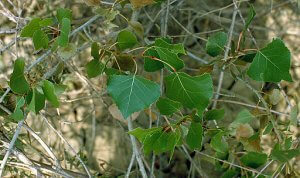
This was a surprise to me when I learned that not only are cottonwood leaves edible but they are extremely nutritious. According to a very reputable edible plant database (pfaf.org) cottonwood leaves contain a greater amino acid content then rice, corn, wheat, and barley. One problem I see with eating cottonwood leaves is the taste. This is a tree that is very abundant in my area and I have eaten small portions of cottonwood leaves before, but they tend to be very bitter. This bitterness might be able to be reduced by cooking or drying but I have not had the opportunity to experiment with that yet.
Health Benefits of Cottonwood Buds
Cottonwood buds and bark contain salicin which is a compound that likely breaks down into salicylic acid(asprin). Preparation of cottonwoods buds or bark with oil, or alcohol can make a natural medicinal product with similar properties to aspirin. This would be used externally or internally for pain relief, inflammation or fever. Other medicinal uses of cottonwood bark have been recorded such as treatment of whooping cough, tuberculosis, colds, and intestinal parasites. Whenever you make a product that concentrates the compounds of an edible plant the product may not be edible anymore, use caution if using any concentrated product internally. A closely related species (Populus balsamifera) is used to make a North American version of balm of gilead, a fragrant oil with medicinal benefits. These benefits are likely very similar to eastern Cottonwood buds and bark.
Cautions
There are no major cautions associated with the plant, buds or leaves other than that some people may be allergic to cottonwood sap. There seems to be a link between people who are sensitive to bees also being sensitive to cottonwood sap. Exercise caution anytime you use a new product externally or internally.
Key ID Features
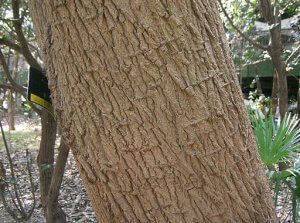
One good identification feature for cottonwood trees is their size, but that doesn’t help someone who is trying to harvest cottonwood buds or leaves. Another good identification feature is their deeply furrowed bark. These 2 features are shared by other related species such as the tuliptree(Liriodendron tulipifera). The leaf shape of cottonwood trees will set them apart from tuliptrees. Tuliptrees have very distinctive leaves. Cottonwood leaves are triangular with course teeth along the margins. Cottonwood buds are also somewhat distinctive, in winter and early spring they are large, long, and pointed. One last identification feature is to follow the cotton in early summer. Put all these identification features together and you should be able to confidently identify cottonwood trees.
Conclusion
This is one of those plants that a lot of people are aware of but many people simply view as a weed tree. Not only is this tree a native plant but it offers impressive nutritional and medicinal benefits as well. I would encourage more people to experiment with eating cottonwood buds and leaves in different ways. In my opinion this plant could be an important edible plant because of its high amino acid content, especially for people that don’t eat meat. If you love to try new wild edibles, give this a try and leave a comment below with your experiences.
Many of our readers find that subscribing to Eat The Planet is the best way to make sure they don't miss any of our valuable information about wild edibles.
See our privacy policy for more information about ads on this site

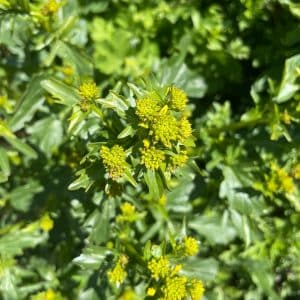
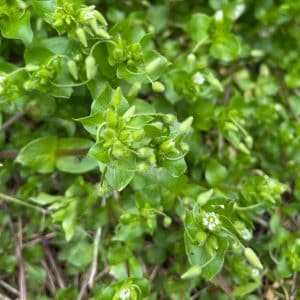
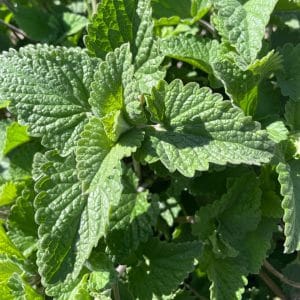


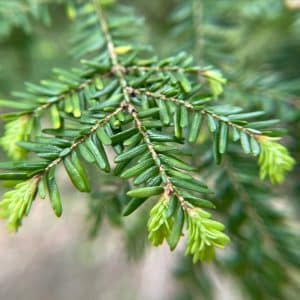
16 Responses
Let’s see: I feel full. now let’s get to the taste: have you… smelled bleach? Imagine that, in your mouth. it tastes like you literally opened up your washer, which had laundry detergent and bleach in it, and took out one of the t-shirts which you bleached extra hard, and just ate it. but then again I ate these leaves when they were dead so it may taste different (can you eat them when browned?) I haven’t tried cooking them yet. I think they’d taste better in pill form desu, maybe in a protein powder. I know this, that usually when you add garlic to these types of deals the bitterness cancels out and it turns semi sweet. I think maybe the best case scenario would be sort of a glaze mixed vegetable dish with loads of garlic)
I like your description of the taste. I rather enjoy finding descriptive comparisons such as yours to describe the taste of certain plants. I have eaten cottonwood leaves and they do not taste good, I agree with you there. I also have not tried cooking them. I’m hoping someone comments with a way to make the whole experience taste a little better.
Human bodies know what is good and what is bad, chemically and nutritionally, by TASTE.
Plants don’t want to be eaten, and they protect themselves by making bad-tasting chemicals, but also, usually, by adding in alkaloid chemicals with toxic properties. Those alkaloids are the chemicals that usually provide the body-altering effects we make use of for our medical needs–but those effects come at the cost of being just below toxicity. Usually to the liver and/or kidneys, sometimes other organs as well. Caffeine, nicotine, pre-aspirin; all are bitter in pure form. They taste terrible. They kill very small animals, specifically the insects. ALL are TOXIC.
My point is, if you forage for wild edibles, and something tastes bad, DON’T EAT IT. Listen to the wisdom of your body when it says “don’t eat this.” We know when something is medicinally beneficial; there’s no need to *force* a medicinal plant into a the role of a food-plant.
We benefit from the wisdom of a hundred millennia. In springtime, when we’re craving green leaves, linden leaves are delicious; as are nettles and cattail shoots. There is no need to reject these gifts of nature discovered by our ancestors so long ago! Eat what TASTES GOOD!
Excellent response and totally on point!
I’m sorry, I have to disagree with you on that.
Some species of poisonous mushrooms, (both mildly and fatally), taste good. Dandelion greens taste bad and are actually highly edible and nutritious. Wheatgrass is far from delicious. Cow’s milk is not easily digestible for a great many people and tastes wonderful! That doesn’t mean we should be drinking it.
People harvest shellfish that sometimes contain a bacteria or virus that can kill them and yet the flavor is still amazing.
I’m not sure what you’re being this idea on but if you have any kind of reliable source please post it. I would like to check it out.
Not sure ingesting it but been using as a tincture in carrier oil much like ur used to seeing dor essential oils. Haven’t tried diffusing but want to do anyone that has info on this in oil being diffused if there are any known health benefits using this method… anyway I think it was used more externally & if I had a guess the bitter taste might be it… I heard ppl could eat dandelions as a salad ….one of the most bitter things I’ve ever tasted. If ppl aren’t eating it commonly rt now there is usually good reason behind it. Lol
I make a great ointment for arthritis with cottonwood bud, dandelion flower and sweet violet leaves. My aunt uses this on her hands before bedtime. One morning she showed me her gnarled and painful hands and said that she had forgotten to use the ointment the night before. What. A. Difference!
thanks, for the story, Thats encouraging, I wish science would fund more studies into things like this. but obviously they wont because there is no money in it.
How do you make it
You forgot to mention that natives chewed on cotton-tree bark, in order to get vitamin C.
I really like pfaf, but I wish that they would include plant’s mycorrhizal associations in the database. Eastern Cottonwood, like all members of the Salicaceae family are both endo -and- ecto mycorrhizal. This means that they can share resources through their networks with something like an eleagnus (endo) on one side, and a hazelnut (ecto) on the other. Throw another dual networking plant into the mix, like a creeping wintergreen (ecto and ericoid) and you can link up a blueberry bush (ericoid) to the whole network. Blueberry and hazelnut paste sandwiched between layers of young green cottonwood leaves?
That’s all something I’ve got to look into more. That’s really interesting stuff.
You could use this in a green smoothie and flavor to your liking! No one mentioned dose which I think is very important! How many leaves equal good, and how many is bad?
Can you suggest a site that sells organic cottonwood buds? Found some on Amazon but hesitant to buy. Thanks
Kathleen
I have tons of cottonwoods near my house, so I’ll definitely be experimenting with how to cook them. So far, I’m planning on trying old vs new leave, 2 leaves vs 10, and then natural flavor vs sauteed with garlic. I’ll try and update as soon as I’ve tried them! Also if anyone could give me some pointers on using the bark or leaves for essential oils I’d greatly appreciate it.
I am mobility-challenged and looking to pay someone interested in harvesting lots of Cottonwood buds for me. Please contact me at hay_jaded0v@icloud.com